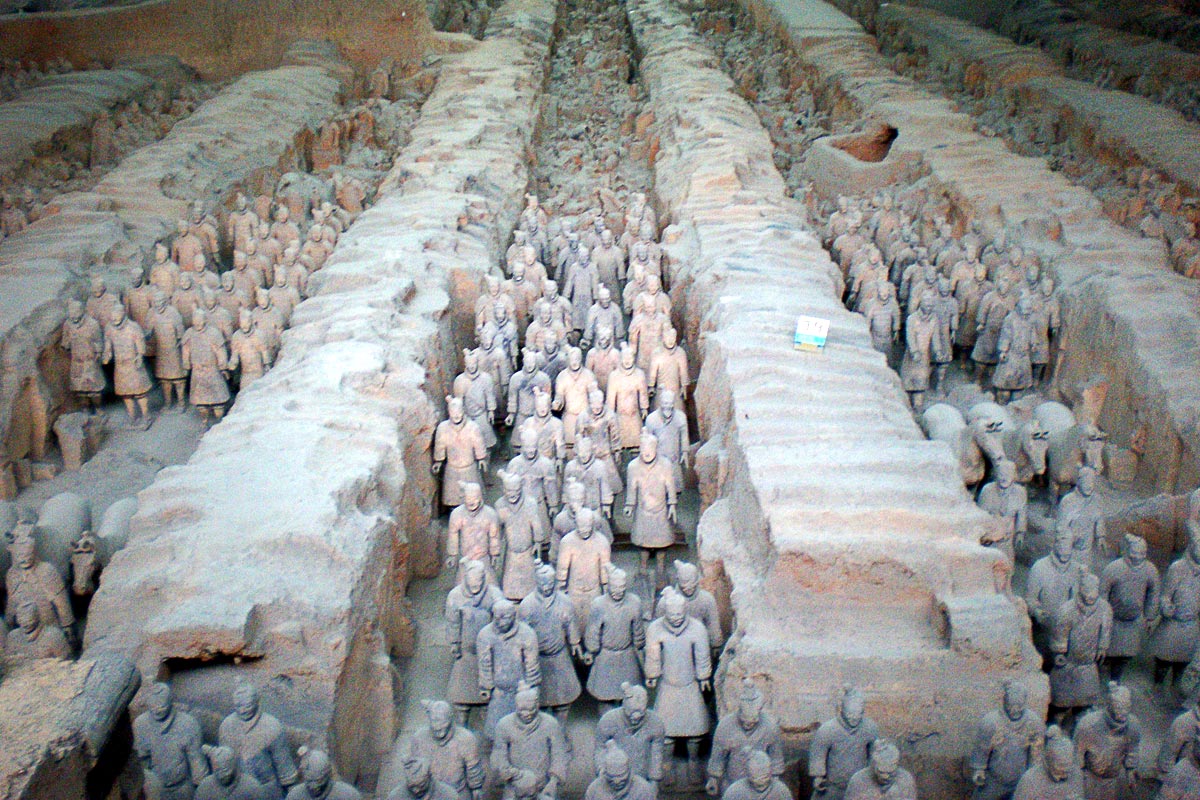
The General sat
and the lines on the map
moved from side to side.
—Pink Floyd
Yes, a vague lifelong dream can happen in real life thanks to travel.
After reading about the so-called Terra-cotta Army in central China many years ago, it has always been a personal daydream that I could go there myself some day. I was attracted by their weird appeal – a vast regimen of ancient clay ghosts decreed by Emperor Qin Shi Huang for his own honor after his 221 BC death and painstakingly being resurrected for us to enjoy in the modern world – and the fact that these soldiers may have well been on the moon.

I mean, central China?! Why and how would I ever go there?
But years later I ended up teaching English in Japan, and suddenly traveling to places in Asia wasn’t such an alien idea.
And now finally the time has come: ninety days in the People’s Republic and Xi’an, the big ancient city near the warriors, is the first stop. (The usual disembarkation points of Beijing and Shanghai just didn’t hold the same interest for me when I was planning this part of the trip.)
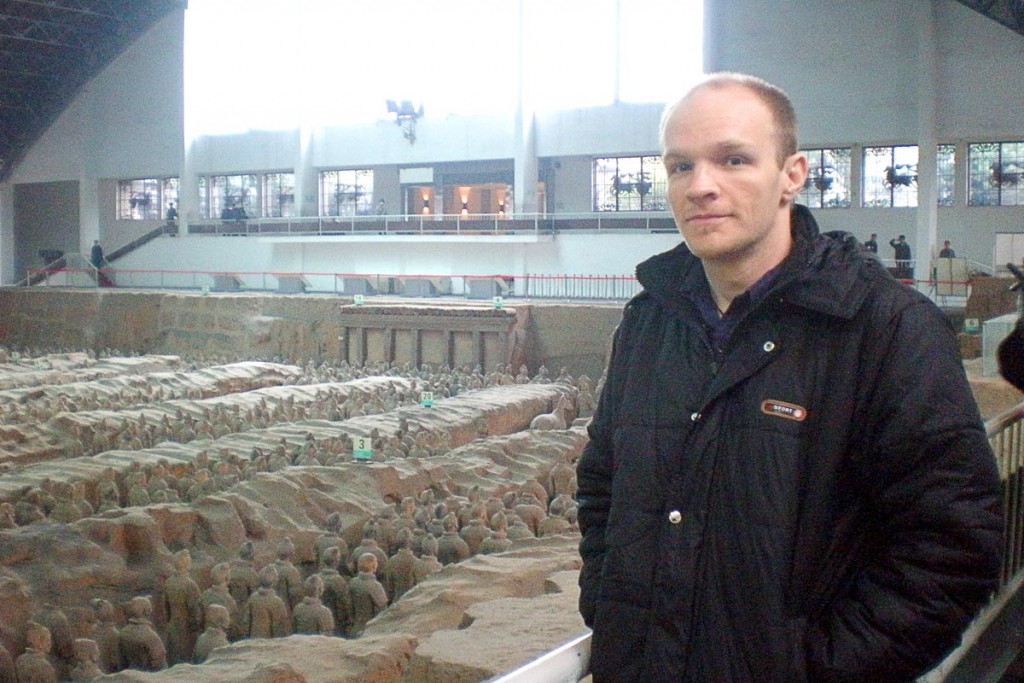
The guided tour
Soon after getting our bearings in Xi’an, we found a guided tour of the Terra-cotta Warrior complex. We rarely take guided tours anywhere; we’d rather see things on my own terms at my own pace, and many things that have guided tours are too touristy and uninteresting to begin with. But this was an exception; a guided tour was simply a way to get there and back with a minimum of fuss.

Me, our tour guide, and Masayo.
The tour was small, and so was the van that picked us up from our hotel — besides us there was a Chinese couple and a lone French tourist. The guide was a friendly, competent local guy who, when I told him I was from America, said “Oh! My dream!”
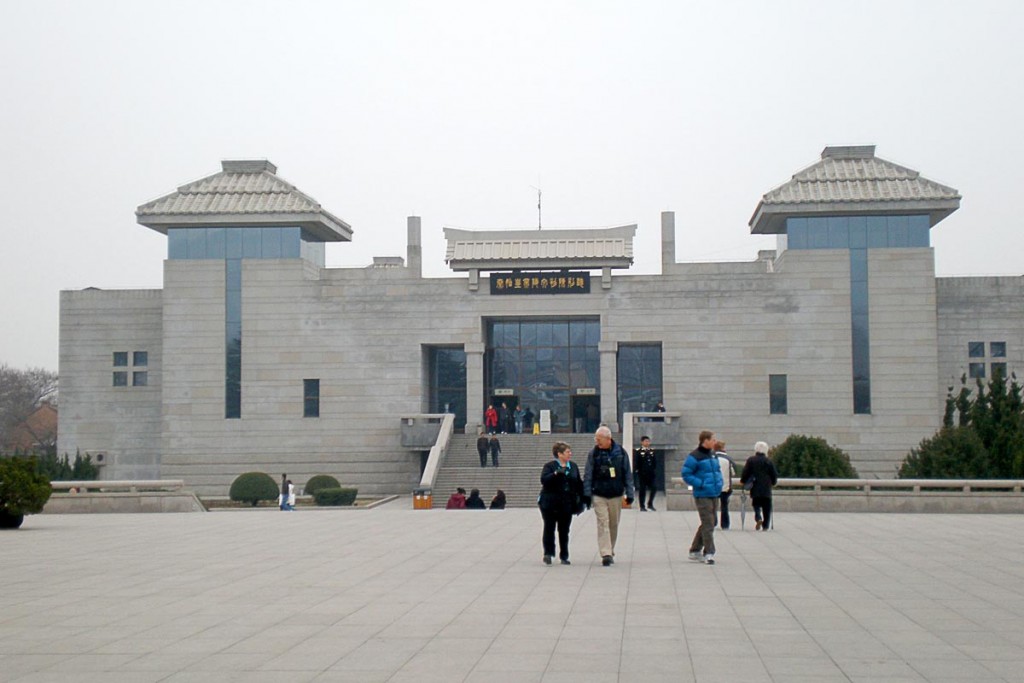 He didn’t try to shunt us around to endless tourist souvenir shops, as had been our experience in George Town, Malaysia, except for a brief (and actually interesting) visit to a rug weaver’s; as a tour it was pretty perfect. The tour proper began with the Terra-cotta Army at the Mausoleum of the First Qin Emperor complex (a UNESCO World Heritage Site; 秦始皇兵马俑, or Qin Shi Huang Bing Ma Yong in Chinese), took in a large “private buffet” style lunch at a nearby restaurant, and then ended at the Small Wild Goose Pagoda.
He didn’t try to shunt us around to endless tourist souvenir shops, as had been our experience in George Town, Malaysia, except for a brief (and actually interesting) visit to a rug weaver’s; as a tour it was pretty perfect. The tour proper began with the Terra-cotta Army at the Mausoleum of the First Qin Emperor complex (a UNESCO World Heritage Site; 秦始皇兵马俑, or Qin Shi Huang Bing Ma Yong in Chinese), took in a large “private buffet” style lunch at a nearby restaurant, and then ended at the Small Wild Goose Pagoda.

The Terra-cotta Army
It was a bitterly cold, drizzly, grey morning when we arrived at the main Terra-cotta Army site. (That’s what you get for going to central China in March.) There are three buildings, the first being the biggest and where most photographs of the Army are taken, and we took ours, of course. (Paul Theroux, who toured China by train in 1986 and wrote about it in the excellent book Riding The Iron Rooster, mentions that at that time photographs were not allowed at all. There’s no problem with taking photos now. An example of China’s opening up in recent times, perhaps.)

Shaanxi Province is shaped like a crouching terra-cotta warrior.
The main building is like a big warehouse, and way less than half has actually been excavated. The work began from the front, and in photos you can see the flat dirt behind the reconstructed warriors — this is the part that workers concentrate on at night, after the tourists leave. They carefully dig up the warriors and then begin the intricate, demanding task of piecing them back together; the figures are smashed into hundreds of pieces when first unearthed.

Making figurines for the tourists, by hand.
The other two buildings are much smaller, but contain some more interesting things — figures of horses, chariots, and the like. A museum of sorts adds to the experience in one of the smaller buildings – this is the only place you can get really close to any Terra-cotta warriors, who reside in glass cases with explanatory cards. The guide pointed out how the province of Shaanxi, where the Army and Xi’an are both located, is shaped like the silhouette of a crouching warrior holding a spear. (I asked him how the people in southeastern Shaanxi, occupying the warrior’s ass, felt about their lot; he laughed.)
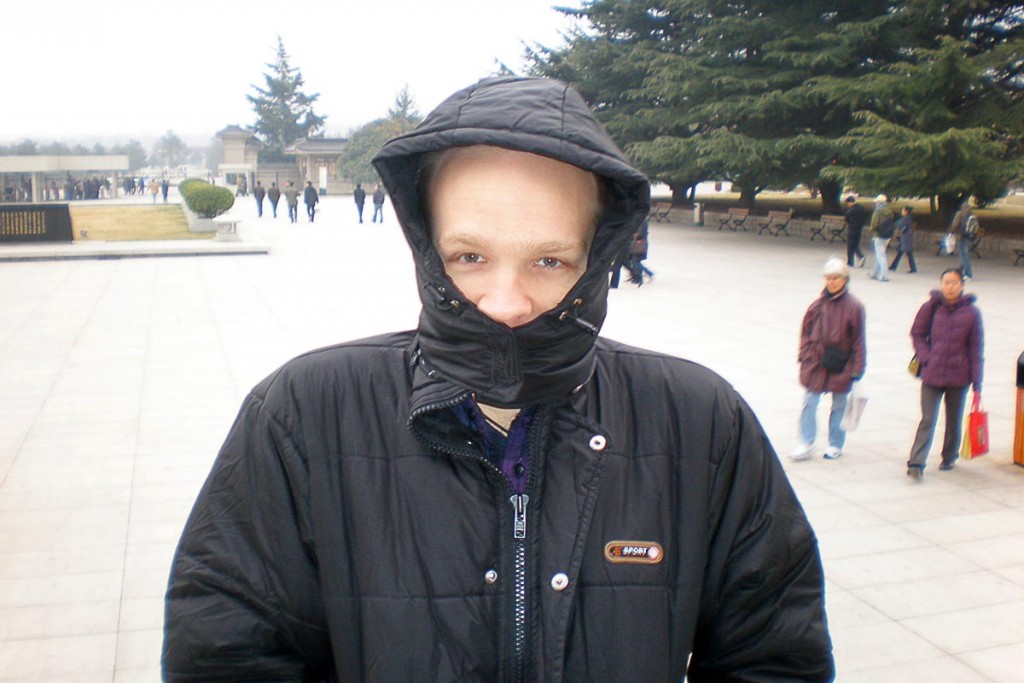
Although the warriors were originally brightly painted and were holding actual weapons, the fact that they are now monochrome — a blurry brown-grey — made seeing them on that chilly, bleak day even more striking: they may match their surroundings but still they manage to stand out, and stand strong after hundreds of years.
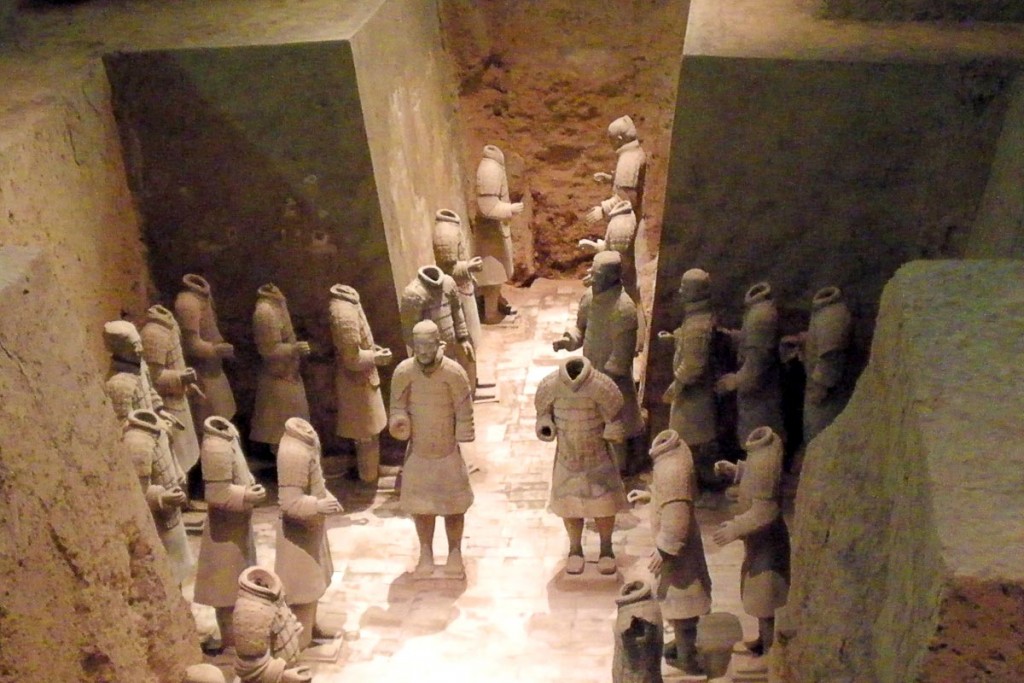
Nobody knew about their existence until local residents hit upon them while digging with a shovel in 1974, and it was truly an amazing find — as Paul Theroux points out, the Terra-cotta Army is a rare instance of Mao’s China correctly and delicately preserving a real national treasure (even if it is for the purpose of tourism rather than historical respect) rather than destroying for the hell of it. Incidentally, one of the farmers who first dug up the warriors was actually in the gift shop the day we were there – now an old man, selling signatures and taking questions, although I couldn’t think of anything to ask him. Didn’t even get a photo. Always take photos, Jeremy!

Lunch
For lunch the five of us tourists were taken to a nearby restaurant where we sat at a big round table, in the middle of which was a large-sized Lazy Susan spinning section. Servers brought endless plates and bowls of different kinds of food – vegetables, noodles, meats – and we’d spin them around, doling out what we wanted and drinking bottomless cups of tea. Masayo and I were packed full to the gills, but the food was perfect.

It was around here that we also were taken to the weaving shop. It was, in its way, a ruse to get us to buy weavings, but it was genuinely interesting: on giant vertical looms the workers took months to create large pieces full of wondrous colors and designs. A big back room contained piles of weavings for sale. They were way out of our price range, hundreds of dollars, and in fact I wouldn’t have any need for a giant weaving even if it were free. So we politely declined, but I quite enjoyed the little side trip despite its sleazy touristic bent.
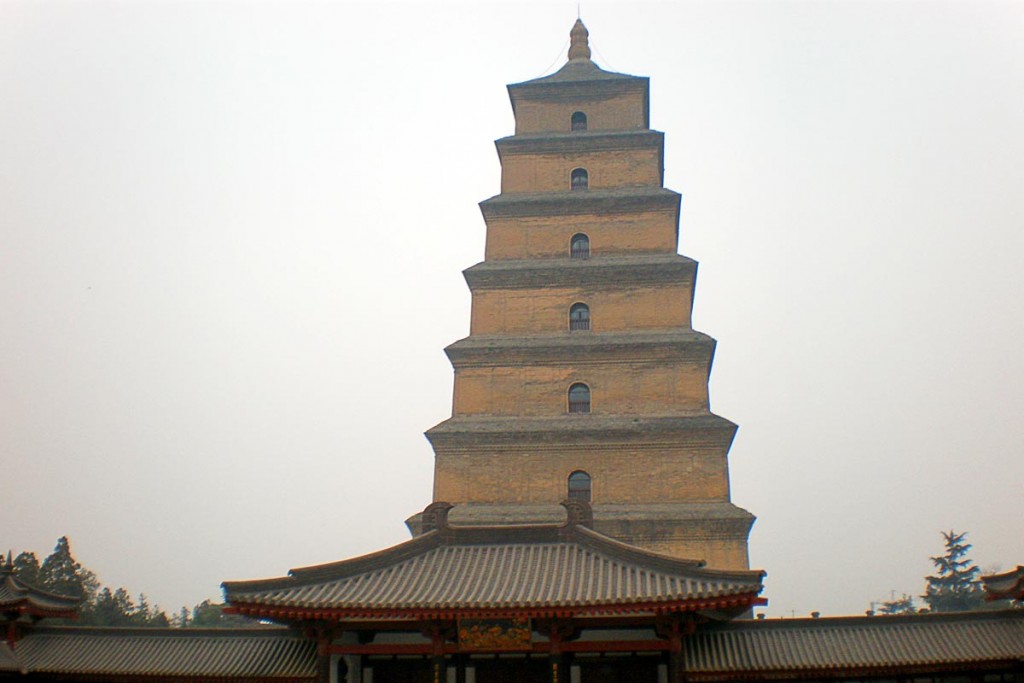
The Small Wild Goose Pagoda
Rising 43 meters and consisting of fifteen tiers, the Small Wild Goose Pagoda (Xiaoyan Ta, or 小雁塔) in Xi’an dates from the eighth century Tang Dynasty, and it was our last stop on the tour. We watched people lighting candles and lost ourselves in the ancient-looking art and architecture of the area. Without knowing exactly what we were seeing, I felt yet that this was real China – not a tourist attraction only, but a real live piece of the past, alive and breathing here in the 21st century.

Final thoughts
Wow, only five days into my lengthy China trip and I’ve already had a big highlight. Starting this trip with the Terra-cotta Army couldn’t have been a better choice. From a picture in a book when I was a kid, to seeing the place up close with my own eyes. What an experience.
You don’t have to be into historical relics or Chinese history to enjoy the ancient sites in and around Xi’an and Qin’s Mausoleum – the silent, sturdy warriors who traveled through time to be here with us now are an attraction enough on their own.

Thanks for reading. Suggested:
- Share:
- Read next: Day 7: The amazing food stalls of Kaifeng
- News: Newsletter (posted for free on Patreon every week)
- Support: Patreon (watch extended, ad-free videos and get other perks)

Support independent travel content
You can support my work via Patreon. Get early links to new videos, shout-outs in my videos, and other perks for as little as $1/month.
Your support helps me make more videos and bring you travels from interesting and lesser-known places. Join us! See details, perks, and support tiers at patreon.com/t1dwanderer. Thanks!
